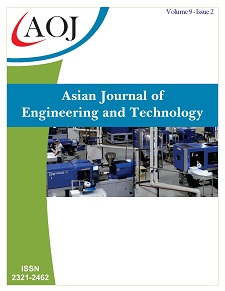Some Workout Problems on Motion of Raindrop
DOI:
https://doi.org/10.24203/ajet.v9i2.6588Keywords:
Rain drop, terminal velocity, air resistance, mass accretion.Abstract
The motion of rain drop through atmosphere is an interesting classical problem because of the fact that air resistance and moisture accretion are integral part of it. Mathematical modeling of it using Newtonian formalism is considered here and discussions are made for no mass accretion and air resistance proportional to nth power of velocity. We use python program and library extensively to find the terminal velocity of rain drop. Graphs show close agreement and velocity power up to n=3 is good.
References
Kshitiz Garg and Shree K. Nayar, Photometric Model of a Rain Drop, www.semanticscholar.org @inproceedings 2003.
K. V. Beard and C. Chaung. A new model for the equilibrium shape of raindrops. Journal of Atmospheric Science, vol. 44 no. (11), pp. 1509–1524, 1987.
J. S. Marshall and W. M. K. Palmer. The distribution of raindrops with sizes. Journal of Meteorology, vol. 5, pp. 165–166, 1948.
R. M. Manning. Stochastic Electromagnetic Image Propagation. McGraw-Hill, Inc, 1993.
R. Gunn and G. D. Kinzer. The terminal velocity for water droplet in stagnant air. Journal of Meteorology, vol. 6, pp. 243–248, 1949.
Ben Lynch and Gavin Lommatsch, Modeling the velocity of a raindrop, May 6, 2011, http://home2.fvcc.edu/~dhicketh/DiffEqns/Spring11projects/Ben_Lynch_Gavin_Lom matsch/DiffEqProject/DiffEqProjectGavinBen.pdf [8 August 2012]
K. S. Krane, American Journal of Physics vol. 49, pp. 113–117, 1981; doi: 10.1119/1.12537.
I. Adawi, American Journal of Physics vol. 54, pp. 739–740, 1986; doi: 10.1119/1.14465.
Alan D. Sokal1, American Journal of Physics vol. 78, pp. 643-645, 2010; doi: 10.1119/1.3246871.
M. H. Partovi and D. R. Aston, American Journal of Physics vol. 57, pp. 912–920, 1989; doi: 10.1119/1.15846.
Downloads
Published
Issue
Section
License
Copyright (c) 2021 Sneha Dey, Amitava Ghorai

This work is licensed under a Creative Commons Attribution-NonCommercial 4.0 International License.
- Papers must be submitted on the understanding that they have not been published elsewhere (except in the form of an abstract or as part of a published lecture, review, or thesis) and are not currently under consideration by another journal published by any other publisher.
- It is also the authors responsibility to ensure that the articles emanating from a particular source are submitted with the necessary approval.
- The authors warrant that the paper is original and that he/she is the author of the paper, except for material that is clearly identified as to its original source, with permission notices from the copyright owners where required.
- The authors ensure that all the references carefully and they are accurate in the text as well as in the list of references (and vice versa).
- Authors retain copyright and grant the journal right of first publication with the work simultaneously licensed under a Attribution-NonCommercial 4.0 International that allows others to share the work with an acknowledgement of the work's authorship and initial publication in this journal.
- Authors are able to enter into separate, additional contractual arrangements for the non-exclusive distribution of the journal's published version of the work (e.g., post it to an institutional repository or publish it in a book), with an acknowledgement of its initial publication in this journal.
- Authors are permitted and encouraged to post their work online (e.g., in institutional repositories or on their website) prior to and during the submission process, as it can lead to productive exchanges, as well as earlier and greater citation of published work (See The Effect of Open Access).
- The journal/publisher is not responsible for subsequent uses of the work. It is the author's responsibility to bring an infringement action if so desired by the author.



